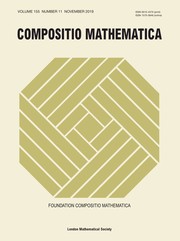We prove the analogue of the Ax–Lindemann–Weierstrass theorem for not necessarily arithmetic lattices of the automorphism group of the complex unit ball  \mathbb{B}^{n} using methods of several complex variables, algebraic geometry and Kähler geometry. Consider a torsion-free lattice
\mathbb{B}^{n} using methods of several complex variables, algebraic geometry and Kähler geometry. Consider a torsion-free lattice  \unicode[STIX]{x1D6E4}\,\subset \,\text{Aut}(\mathbb{B}^{n}) and the associated uniformization map
\unicode[STIX]{x1D6E4}\,\subset \,\text{Aut}(\mathbb{B}^{n}) and the associated uniformization map  \unicode[STIX]{x1D70B}:\mathbb{B}^{n}\rightarrow \mathbb{B}^{n}/\unicode[STIX]{x1D6E4}=:X_{\unicode[STIX]{x1D6E4}}. Given an algebraic subset
\unicode[STIX]{x1D70B}:\mathbb{B}^{n}\rightarrow \mathbb{B}^{n}/\unicode[STIX]{x1D6E4}=:X_{\unicode[STIX]{x1D6E4}}. Given an algebraic subset  S\,\subset \,\mathbb{B}^{n} and writing
S\,\subset \,\mathbb{B}^{n} and writing  Z for the Zariski closure of
Z for the Zariski closure of  \unicode[STIX]{x1D70B}(S) in
\unicode[STIX]{x1D70B}(S) in  X_{\unicode[STIX]{x1D6E4}} (which is equipped with a canonical quasi-projective structure), in some precise sense we realize
X_{\unicode[STIX]{x1D6E4}} (which is equipped with a canonical quasi-projective structure), in some precise sense we realize  Z as a variety uniruled by images of algebraic subsets under the uniformization map, and study the asymptotic geometry of an irreducible component
Z as a variety uniruled by images of algebraic subsets under the uniformization map, and study the asymptotic geometry of an irreducible component  \widetilde{Z} of
\widetilde{Z} of  \unicode[STIX]{x1D70B}^{-1}(Z) as
\unicode[STIX]{x1D70B}^{-1}(Z) as  \widetilde{Z} exits the boundary
\widetilde{Z} exits the boundary  \unicode[STIX]{x2202}\mathbb{B}^{n} by exploiting the strict pseudoconvexity of
\unicode[STIX]{x2202}\mathbb{B}^{n} by exploiting the strict pseudoconvexity of  \mathbb{B}^{n}, culminating in the proof that
\mathbb{B}^{n}, culminating in the proof that  \widetilde{Z}\,\subset \,\mathbb{B}^{n} is totally geodesic. Our methodology sets the stage for tackling problems in functional transcendence theory for arbitrary lattices of
\widetilde{Z}\,\subset \,\mathbb{B}^{n} is totally geodesic. Our methodology sets the stage for tackling problems in functional transcendence theory for arbitrary lattices of  \text{ Aut}(\unicode[STIX]{x1D6FA}) for (possibly reducible) bounded symmetric domains
\text{ Aut}(\unicode[STIX]{x1D6FA}) for (possibly reducible) bounded symmetric domains  \unicode[STIX]{x1D6FA}.
\unicode[STIX]{x1D6FA}.










































